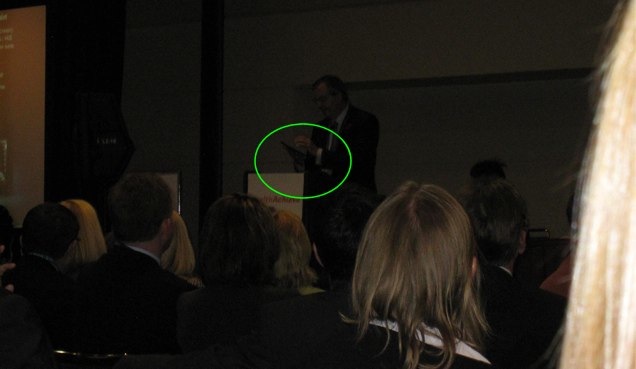The focus of the opening session of the eHealthAchieve track was on “smart mobility and clinical collaborationâ€. There was a panel presentation by IBM, RIM, and Toronto East General Hospital.
IBM’s presentation was focused on the benefits of technology in health care settings, namely 1) improving operational effectiveness, 2) achieve better outcomes and quality, and 2) deliver collaborative care (i.e., new models of care). Social media/networks was also discussed as a vector for further investigation. Given the time constraints, the presenter wasn’t able to go into much detail as to the specific work that they are doing.
The second presentation was from RIM on their work in health care. The presenter shared some stories/case studies about new ways of using technology by care givers to do their job faster and better. RIM also highlighted their role of delivering solutions in a *secure* manner. I think there was a brief glimpse of a PlayBook device before it was put away. The PlayBook was also brought out and talked about how it might be useful in health care applications.

Toronto East General Hospital (TEGH) made a presentation on mobile devices based on their experience. Their main takeaway was “start small but think bigâ€. Think big in terms of returns, process improvements, and changes, but start with small projects. TEGH’s use of the Vocera system was presented. It was interesting to see a relatively simple solution result in some impressive process improvements. An interesting tidbit was that TEGH did a “big bang†switch in terms of the EHR – no single unit roll-out. This reminds me of Dr. Dean Ornish’s (controversial) assertion that to effect change, people need to see immediate (if not radical) gains to maintain them.
Some of my personal observations:
- Not surprisingly, there seemed to be an unspoken acknowledgement of technological determinism which is to say that technology will make things better.
- The room was relatively full. Actually, I was surprised at the turn-out given the time (it started at 0830) and also because it was at the same time as the Nick Vujicic, a motivational speaker. Nick was born without limbs and his story is very inspiring and motivating.
- The focus of the technology providers was on health care professionals (i.e., physicians). I only heard the speakers mention the word “patient†only 1 time. Not really surprising.
- On a side note, the TEGH presentation was a good contrast to the previous two presentations in that the slides were simple and easy to read (i.e., not so busy) and the speaker was clear and seemed relaxed.
Comments
2 responses to “HealthAchieve 2010: eHealthAchieve opening session (Day 2 morning)”
Toronto East General was involved in the 2nd arm of the Cancer Care Ontario Waiting Time Study.
, I think that information about how these ideas might be put into piactrce is lacking. Who besides the judges and Infoway staff are going to see these ideas? Once the judging is complete, will these ideas be shared publicly? How will they influence future health IT investments? Speaking of judges, who will be judging? Why is public voting limited to selecting a people’s choice award? Why not make public input one of the criteria for selecting the other winners? (say 10% to 20% of the score for each entry is based on public voting). Or, at the very least, allow the public to nominate and select a % of the judges? The public will be the final arbiter of whether our investments in health IT are making a difference. The eHealthAchieve results and my personal poll of friends and acquaintances lead me to believe that we have a long way to go to justify the investments to date. I am hopeful that future investments will build on the infrastructure that we have in put in place and that we will start to see health IT have more direct impact on the delivery of care that most people experience.I have another idea that I have suggested to others at Infoway. You cited several anecdotal stories of how health IT has made a noticeable impact on people’s care. How about providing a vehicle for people to submit and share their stories? You could create a You Tube channel, for example, or another microsite on which people could post their stories. Other organizations are effectively leveraging social media to let their customers share their stories. Why not take advantage of this technology to let Canadian tell their health IT stories?Michael MartineauehealthMusings.ca